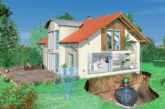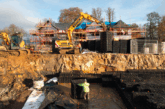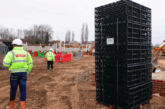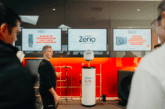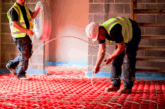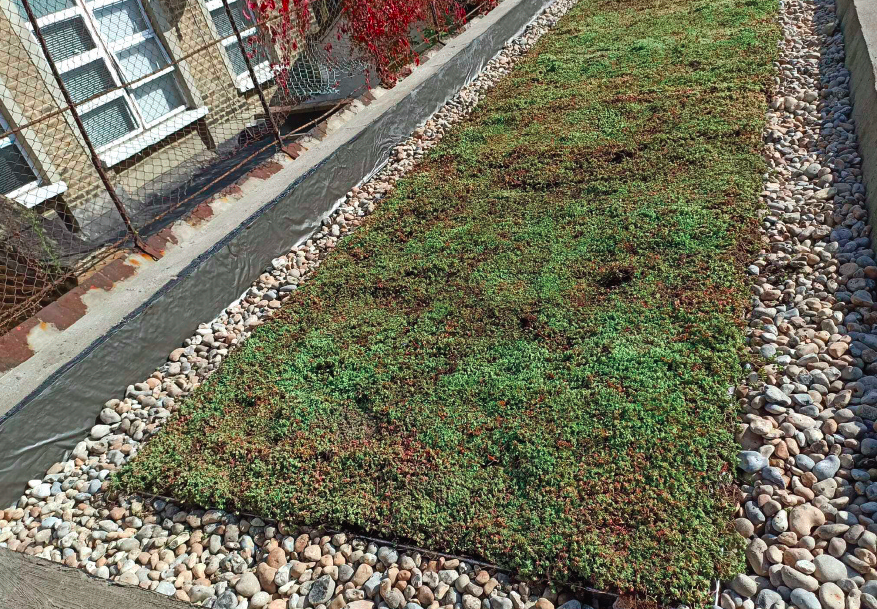
With water shortages becoming increasingly common in the UK, those in the construction industry will need to familiarise themselves with sustainable practises and solutions. For construction professionals working on buildings with a flat roof, this is where blue roofs come in. Neil Robinson-Welsh, Consultant at AC Building Drainage, highlights four essential benefits blue roofs provide, addressing both water scarcity and stormwater management.
Getting the hang of blue roofs
Blue roofs are a sustainable drainage system (SuDS) designed to temporarily hold and slowly release rainwater, helping to manage stormwater in an environmentally responsible way. While conventional flat roofs drain water quickly, blue roofs slow stormwater runoff, reducing the strain on sewer systems and mitigating flooding, especially in densely populated urban areas. With population growth leading to the expansion of urban areas, coupled with ongoing climate change, this feature is becoming increasingly relevant as higher volumes of stormwater need to be sustainably managed.
It is important that any solutions for managing stormwater meet building standards and are easy to maintain. This helps ensure longevity of the overall water management strategy. Selecting a solution with a modular design, such as ACO’s RoofBloxx, leads to a smoother installation process, reducing the time and complexity involved as units can be assembled and adjusted on site. Developers working on blocks of flats or other flat-roofed buildings are recommended to familiarise themselves with these solutions. Those who do will be in a great position, not only to provide excellent service but also to play their part in alleviating concerns about water availability.
Former Environment Secretary, Steve Reed, has clearly warned that the UK’s water demand will outstrip supply by the mid-2030s unless significant infrastructure improvements are made.
Regions like the South and East of England are already facing significant water stress, with cities such as Cambridge and Oxford particularly impacted, as their ageing water and sewerage infrastructure struggles to meet the demands of growing populations. Since the privatisation of the UK’s water industry in 1989, chronic underinvestment has left the country ill-equipped to manage stormwater effectively. This is just one of the key areas where blue roofs can offer a practical and forward-thinking solution.
Four benefits of blue roofs
- Taking the Pressure Off Our Pipes
Throughout the last decade, heavy rainfall has frequently overwhelmed UK sewer systems, leading to combined sewer overflows (CSOs) that released untreated sewage into rivers and seas. Blue roofs offer a viable solution here – by retaining rainwater on top of apartment blocks and gradually releasing it, the volume of water entering already stressed sewers is reduced, preventing CSOs and the resulting environmental damage. Through this proactive system, blue roofs can provide a sustainable solution to the growing issue of sewer system overload. - Built-In Sustainability
As the climate crisis intensifies, blue roofs are becoming even more crucial for enhancing resilience. With extreme weather events occurring more frequently, cities must adapt many parts of infrastructure, including residential blocks, to both drought and heavy rainfall conditions. Through storing water during storms and gradually releasing it during dry periods, blue roofs mitigate the risk of flash floods while also alleviating drought effects. Working in tandem with vegetation, blue roofs can also limit the urban heat island effect, leading to better environmental conditions in cities. This multipronged approach addresses immediate water management needs as well as bolstering long-term urban sustainability. - Prioritising Water Reuse and Conservation
Not only do blue roofs manage stormwater, but they are also vital for water conservation. By storing and capturing rainwater, they offer another water source for irrigation and landscaping – especially pertinent given the UK’s growing water scarcity. In addition, blue roofs enable water reuse, helping to escape dependence on traditional water supplies while also enhancing self-sufficiency in buildings. Water reuse may include watering a shared garden or used for cleaning residents’ cars and bicycles. This duality in stormwater management and water conservation makes blue roofs an essential asset in combating water shortages. - Designing, Connecting, and Delivering with Expertise
Construction professionals have a critical role to play in incorporating blue roof systems into the UK’s infrastructure. The success of blue roofs also hinges on accurate design and integration, with critical elements such as outlet positioning, roof slope, and the selection of attenuation systems playing important roles. ACO’s RoofBloxx stands out as the only solution engineered to operate independently of the roof’s waterproofing and drainage systems. This enables RoofBloxx to provide precise water retention control while facilitating easy maintenance and long-lasting performance for residential flat blocks, even during extreme weather. The system also complies with building regulations, bolstering overall building resilience.
Shaping the future of climate resilience today It is imperative that blue roofs are seen as essential components of infrastructure upgrades, sustainably and proactively addressing the UK’s water challenges. Construction professionals who engage in any project with a flat roof need to lead the way in implementing these systems, using solutions such as ACO RoofBloxx to ensure optimal performance. By doing so, they can boost the sustainability of their projects and help cities become more climate resilient.
For more information on blue roofs, see www.rdr.link/dbg032


